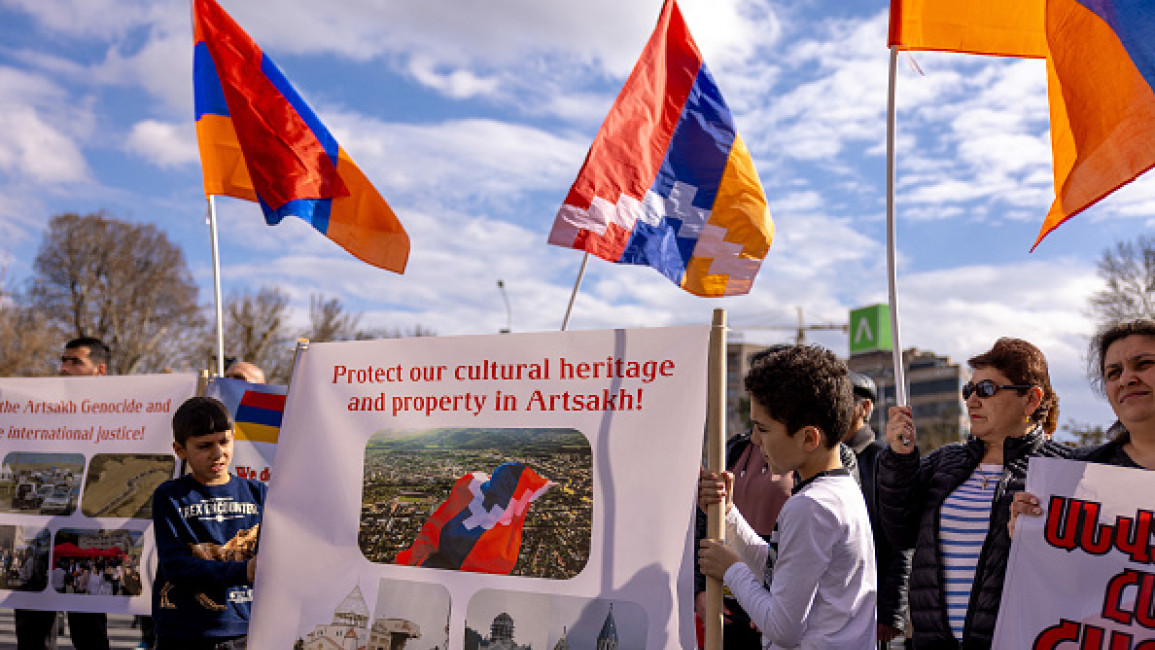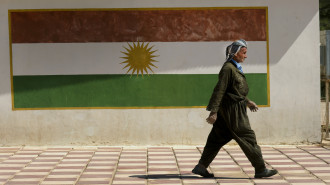
A year in exile: The hopes and fears of Nagorno-Karabakh Armenians

Yerevan, Armenia - Twenty-year-old Susanna Hovsepyan recalls her final September in Nagorno-Karabakh in 2023, passing through an Azerbaijani checkpoint filled with fear as she left her home behind.
Although any military-related item could have endangered her and the other refugees on the bus, she took the risk of hiding her father's army hat, wrapped in her clothes, as a last memory of him.
Her father, a serviceman, died on the frontline on 19 September when Azerbaijan attacked Nagorno-Karabakh after a nine-month blockade of the region.
"They stopped the bus twice to search it, mocking and scaring us," recalls Hovsepyan. "When we crossed the Hakari Bridge and entered Armenia, it felt like we were reborn. We all started to cry," Susanna told The New Arab.
The 19th of September marks one year since Azerbaijan launched an attack on Nagorno-Karabakh (also known as Artsakh among Armenians) in 2023, a self-governed region inhabited by ethnic Armenians in the South Caucasus that has been at the centre of a decades-long territorial dispute between Armenia and Azerbaijan.
After Azerbaijan took control over the region, more than 100,000 Armenians - almost the entire population of Nagorno-Karabakh - fled to Armenia within a week. They are now spread across different regions in Armenia, with the fading hope that they will be able to return to their ancestral homes.
The right to return of refugees
The Armenian Apostolic Church has maintained the Artsakh Diocese, which is now taking responsibility for the displaced community.
Bishop Vrtanes Abrahamyan, Primate of the Artsakh Diocese, had a number of meetings with Nagorno-Karabkah Armenians in the past year and talked to them about their main concerns.
“As a result of my discussions with the community, I can confirm that over 80 percent of Artsakh citizens are willing to return if only one condition is met - that Artsakh will not be under Azerbaijani control,” said Bishop Abrahamyan, adding that this percentage could rise further if international security guarantees are also provided.
On 17 November 2023, the International Court of Justice ordered Azerbaijan to allow Armenians from Nagorno-Karabakh to return there "in a safe, unimpeded and expeditious manner".
|
|
During the blockade of Nagorno-Karabakh and the mass exodus that followed, Azerbaijan officially claimed that the local Armenian population was welcome to stay and could be integrated into Azerbaijani society.
However, Dr Andrew Forde, Assistant Professor of International Law at Dublin City University, finds these statements “deeply disingenuous” and believes they “ring quite hollow”.
“Azerbaijan made these claims while enforcing a months-long blockade under false pretences, depriving people of their freedom of movement and basic necessities. It continued to say this even as civilian infrastructure was being damaged and anti-Armenian rhetoric was rampant in politics and the media,” he explained.
“Essentially, Azerbaijan was telling the Armenian population they were welcome to stay in Nagorno-Karabakh while holding a gun to their heads, metaphorically, if not literally.”
He also emphasised that for any potential return of Armenians, key conditions must be met, including accountability, safety and security guarantees, property reparations, and the broader issue of self-government or autonomy.
“These are essential, especially given the evidence of Azerbaijan demonising Armenians in a very insidious, mainstream manner,” he added.
Endangered Armenian cultural heritage
Another major concern among the displaced community is the preservation of the cultural and spiritual heritage of Nagorno-Karabakh, which is now endangered.
“I must express with sorrow that our historic monasteries and churches are being destroyed. It is also deeply distressing that the cemeteries, which are vital to our memory and serve as a connection between the living and their deceased relatives, are being desecrated,” said Bishop Abrahamyan.
Evidence of the destruction of centuries-old Armenian churches and cemeteries has been recorded in the latest reports from the Caucasus Heritage Watch, a heritage monitoring and forensic research organisation hosted by Cornell University.
“If forced displacement severed our physical connection with Artsakh, then the destruction of our holy churches there might sever our spiritual connection,” said Bishop Abrahamyan. He emphasised that international organisations remain silent on this issue while the “vandals act with impunity”.
According to Gegham Stepanyan, the Artsakh Ombudsman and a member of the newly formed Committee for the Defence of the Fundamental Rights of the People of Artsakh, the preservation of the Armenian footprint in the region is the most urgent concern, whereas their long-term purpose is to recover the rights of the displaced population and return to Nagorno-Karabakh.
“For now, our main desire is to establish a platform with the involvement of international mediators where the issues of the displaced population will be addressed,” said Gegham Stepanyan in a conversation with The New Arab.
|
|
A handful of Armenians left in Nagorno-Karabakh
The Armenian government is offering citizenship to those displaced from Nagorno-Karabakh, which will grant job privileges and housing assistance to refugees. According to the latest data from the Migration and Citizenship Service of the Ministry of Internal Affairs of the Republic of Armenia, of the 115,500 forcibly displaced, only 4,300 have applied for Armenian citizenship.
Gegham Stepanyan explained that there is a concern around the displaced population that citizenship might deprive them of their right to return.
“According to international law, the right to return will remain even if the refugee acquires the citizenship of another country. However, for the international actors the issue might lose its urgency, as the acquisition of citizenship itself implies a high level of human rights protection,” he stressed.
Today, only 14 Armenians are left in Nagorno-Karabakh, most of whom have mental or physical health issues, Stepanyan said.
“During the past year, several dozen Armenians who remained in Nagorno-Karabakh asked the Red Cross to transfer them to Armenia. This proves that even those who hoped to stay in their homes and continue to live there later came to the conviction that it is impossible,” said Stepanyan, stressing that they can regularly see videos from Azerbaijanis where some of the remaining Armenians are being mocked or used for propaganda purposes.
Several human rights organisations are currently working on documenting human rights violations in Nagorno-Karabakh, Stepanyan says. Applications have already been submitted to the International Criminal Court (ICC) and others are being prepared.
A failure to investigate war crimes
Dr Andrew Forde expressed concern that, so far, there is no clear evidence of Azerbaijan seriously investigating the events in Nagorno-Karabakh over the past few years, many of which could constitute war crimes or crimes against humanity.
“During the hostilities, there were reports of soldiers being maimed, allegations of ill-treatment - some involving civilians - and damage to civilian infrastructure, among other concerns. These incidents bear the hallmarks of war crimes, but thorough investigations are needed to confirm that, and such investigations must take place,” Dr Forde stated.
While Azerbaijan is not required to permit external investigators, it is obligated to investigate these alleged crimes in accordance with its duties under international law. As Dr Forde emphasised, a key element of lasting peace in the region must be “accountability and justice for those who have suffered”.
One year after the ethnic cleansing of Nagorno-Karabakh, experts note a lack of sufficient international attention to the crisis in the region.
“It should have received unambiguous condemnation. The failure to comply with the International Court of Justice’s interim order is another low point that should have triggered a response from the UN Security Council,” Dr Forde stated. He is convinced that the international community “faces a credibility crisis when it comes to Nagorno-Karabakh”.
Dozens of Armenians remain in Baku's prisons
While Azerbaijan marked its victory a year ago by declaring that it has solved the Nagorno-Karabakh conflict, 55 Armenian war prisoners and civilians remain in Baku’s prisons, as stated by Armenia’s Investigative Committee. Among them are former high-ranking officials of the Nagorno-Karabakh Republic.
Aiming to secure the freedom of prisoners, several Armenian organisations launched a public information campaign led by Luis Moreno Ocampo, the former ICC Chief Prosecutor, ahead of COP29 in Baku.
During his recent public meeting with Armenians on 13 September in Yerevan, Ocampo stated that what happened in Nagorno-Karabakh should be defined as genocide according to the Convention on the Prevention and Punishment of the Crime of Genocide.
“Those Armenians are kept in Baku as hostages to send a message to Nagorno-Karabakh people: do not return to Nagorno-Karabakh, because if you return, we will kill you or imprison you. The best legal opportunity to protect Nagorno-Karabakh is to prove that this was a genocide, and the victims of genocide cannot be under the authority of a genocider,” he stated.
However, international judicial processes can take years, and it is hard to predict what will follow them.
Meanwhile, the Armenians of Nagorno-Karabakh remain in limbo, fighting not to lose their last hope for justice.
Gaiane Yenokian is a journalist and photographer based in Yerevan, Armenia. She holds a Bachelor's degree in Journalism from Yerevan State University and has seven years of experience in the field. Her areas of focus are the Nagorno-Karabakh conflict, human interest stories, and human rights. She has been recognised with local awards for her journalism.
Follow her on X: @GaianeYenokian
![Nagorno-Karabakh [AFP] Nagorno-Karabakh [AFP]](/sites/default/files/styles/large_16_9/public/media/images/19DBEDA2-6B90-4F5B-9AAB-76FBE49E1834.jpg?h=d1cb525d&itok=8aRljfeO)




 Follow the Middle East's top stories in English at The New Arab on Google News
Follow the Middle East's top stories in English at The New Arab on Google News


